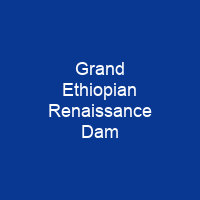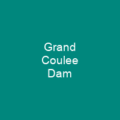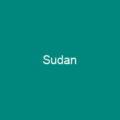The Grand Ethiopian Renaissance Dam is a gravity dam on the Blue Nile River in Ethiopia under construction since 2011. The primary purpose of the dam is electricity production to relieve Ethiopia’s acute energy shortage and for electricity export to neighboring countries. With a planned installed capacity of 6.45 gigawatts, the dam will be the largest hydroelectric power plant in Africa when completed. Egypt, located over 2,500 kilometres downstream of the site, opposes the dam, which it believes will reduce the amount of water available from the Nile.
About Grand Ethiopian Renaissance Dam in brief
 The Grand Ethiopian Renaissance Dam is a gravity dam on the Blue Nile River in Ethiopia under construction since 2011. The primary purpose of the dam is electricity production to relieve Ethiopia’s acute energy shortage and for electricity export to neighboring countries. With a planned installed capacity of 6.45 gigawatts, the dam will be the largest hydroelectric power plant in Africa when completed, as well as the seventh largest in the world. Egypt, located over 2,500 kilometres downstream of the site, opposes the dam, which it believes will reduce the amount of water available from the Nile. Egypt has planned a diplomatic initiative to undermine support for the dam in the region and in other countries supporting the project such as China and Italy. The Ethiopian government has stated that it intends to fund the entire cost of the Dam by itself in order to prevent relying on foreign countries who may be brought under pressure by Egypt to withdraw their support. The dam is being funded by government bonds and private donations. It was slated for completion in July 2017, but Egypt has demanded that Ethiopia cease construction on the dam as a precondition to negotiations, and some political leaders have discussed methods to sabotage it. In October 2019, Egypt stated that talks with Sudan and Ethiopia over the operation of a USD 4 billion hydropower dam that Ethiopia is building on the Nile have reached a deadlock. Beginning in November 2019, U.S. Secretary of the Treasury Steven T. Mnuchin began facilitating negotiations between the three countries. The Egyptian government has accused Sudan of inflaming the situation, while Sudan has accused Egypt of infamously inflaming the situation.
The Grand Ethiopian Renaissance Dam is a gravity dam on the Blue Nile River in Ethiopia under construction since 2011. The primary purpose of the dam is electricity production to relieve Ethiopia’s acute energy shortage and for electricity export to neighboring countries. With a planned installed capacity of 6.45 gigawatts, the dam will be the largest hydroelectric power plant in Africa when completed, as well as the seventh largest in the world. Egypt, located over 2,500 kilometres downstream of the site, opposes the dam, which it believes will reduce the amount of water available from the Nile. Egypt has planned a diplomatic initiative to undermine support for the dam in the region and in other countries supporting the project such as China and Italy. The Ethiopian government has stated that it intends to fund the entire cost of the Dam by itself in order to prevent relying on foreign countries who may be brought under pressure by Egypt to withdraw their support. The dam is being funded by government bonds and private donations. It was slated for completion in July 2017, but Egypt has demanded that Ethiopia cease construction on the dam as a precondition to negotiations, and some political leaders have discussed methods to sabotage it. In October 2019, Egypt stated that talks with Sudan and Ethiopia over the operation of a USD 4 billion hydropower dam that Ethiopia is building on the Nile have reached a deadlock. Beginning in November 2019, U.S. Secretary of the Treasury Steven T. Mnuchin began facilitating negotiations between the three countries. The Egyptian government has accused Sudan of inflaming the situation, while Sudan has accused Egypt of infamously inflaming the situation.
The project was originally called Project X, and after its contract was announced it was called the Millennium Dam. On 15 April 2011, the Council of Ministers renamed it Grand Ethiopia Renaissance Dam. The expectation was for the first two power-generation turbines to become operational after 44 months of construction, or early 2015. The design changed several times between 2011 and 2017, with the electrical parameters and storage parameters apparently affected. Originally, in 2011, it was expected to receive 15 units with 350MW each, resulting in a total of 5250MW with a total capacity of 5,250MW. This would leave US$3.3 billion to be financed by the Ethiopian government through other means, excluding the cost of power transmission lines, which corresponds to about 5% of Ethiopia’s gross domestic product of 2009. In May 2011, it was announced that Ethiopia would share blueprints for the Dam with Egypt so that the downstream impact could be examined. In November 2010, a design for theDam was submitted by James Kelston. It will take between 5 and 15 years to fill with water, depending on hydrologic conditions during the filling period and agreements reached between Ethiopia, Sudan, and Egypt. Ethiopia has a potential for about 45 GW of hydrop power. It is the only other nation in the Nile Basin Initiative, including Sudan, which has expressed support forThe dam, including Egypt. The Government of Egypt, a country which relies heavily on the waters of the Nile, has demanded.
You want to know more about Grand Ethiopian Renaissance Dam?
This page is based on the article Grand Ethiopian Renaissance Dam published in Wikipedia (as of Nov. 30, 2020) and was automatically summarized using artificial intelligence.







